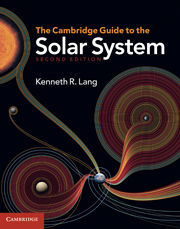Book contents
- Frontmatter
- Contents
- List of focus elements
- List of tables
- Preface to the second edition
- Preface to the first edition
- Principal units
- Part 1 Changing views and fundamental concepts
- Part 2 The inner solar system: rocky worlds
- 4 Restless Earth: third rock from the Sun
- 5 The Earth's Moon: stepping stone to the planets
- 6 Mercury: a dense battered world
- 7 Venus: the veiled planet
- 8 Mars: the red planet
- Part 3 The giant planets, their satellites and their rings: worlds of liquid, ice and gas
- Part 4 Remnants of creation: small worlds in the solar system
- Part 5 Origin of the solar system and extrasolar planets
- Author index
- Subject index
7 - Venus: the veiled planet
from Part 2 - The inner solar system: rocky worlds
Published online by Cambridge University Press: 05 August 2011
- Frontmatter
- Contents
- List of focus elements
- List of tables
- Preface to the second edition
- Preface to the first edition
- Principal units
- Part 1 Changing views and fundamental concepts
- Part 2 The inner solar system: rocky worlds
- 4 Restless Earth: third rock from the Sun
- 5 The Earth's Moon: stepping stone to the planets
- 6 Mercury: a dense battered world
- 7 Venus: the veiled planet
- 8 Mars: the red planet
- Part 3 The giant planets, their satellites and their rings: worlds of liquid, ice and gas
- Part 4 Remnants of creation: small worlds in the solar system
- Part 5 Origin of the solar system and extrasolar planets
- Author index
- Subject index
Summary
• When visible, Venus is the brightest planet in the sky. It orbits the Sun inside Earth's orbit, appearing in the evening or morning hours and never in the middle of the night.
• No human eye has ever gazed on the surface of Venus, which is forever hidden by a thick overcast of impenetrable clouds.
• Venera spacecraft have parachuted through the clouds of Venus, surviving long enough to measure the properties of its torrid surface and even photographing it.
• The deadly efficient greenhouse effect of a thick, carbon-dioxide atmosphere has scorched Venus's surface, raising its temperature to 735 kelvin, even hotter than Mercury's average dayside temperature.
• In size, density and composition, Venus is almost identical to the Earth, but radar signals and space probes have penetrated its clouds to reveal an unearthly surface without a trace of liquid water or life.
• The pale yellow clouds of Venus are composed of concentrated sulfuric-acid droplets.
• The surface of Venus lies under a crushing atmosphere whose surface pressure is 92 times that on Earth.
• It takes only 4 Earth days for the high-flying clouds to move once about Venus, from east to west, blown by fierce, rapid winds, but the slow winds near the surface rotate with the planet, once every 243 Earth days in the same backwards, retrograde direction.
• The high, rapid winds on Venus spiral toward its poles, producing a huge, whirling polar vortex at both poles of the planet. […]
- Type
- Chapter
- Information
- The Cambridge Guide to the Solar System , pp. 220 - 246Publisher: Cambridge University PressPrint publication year: 2011



